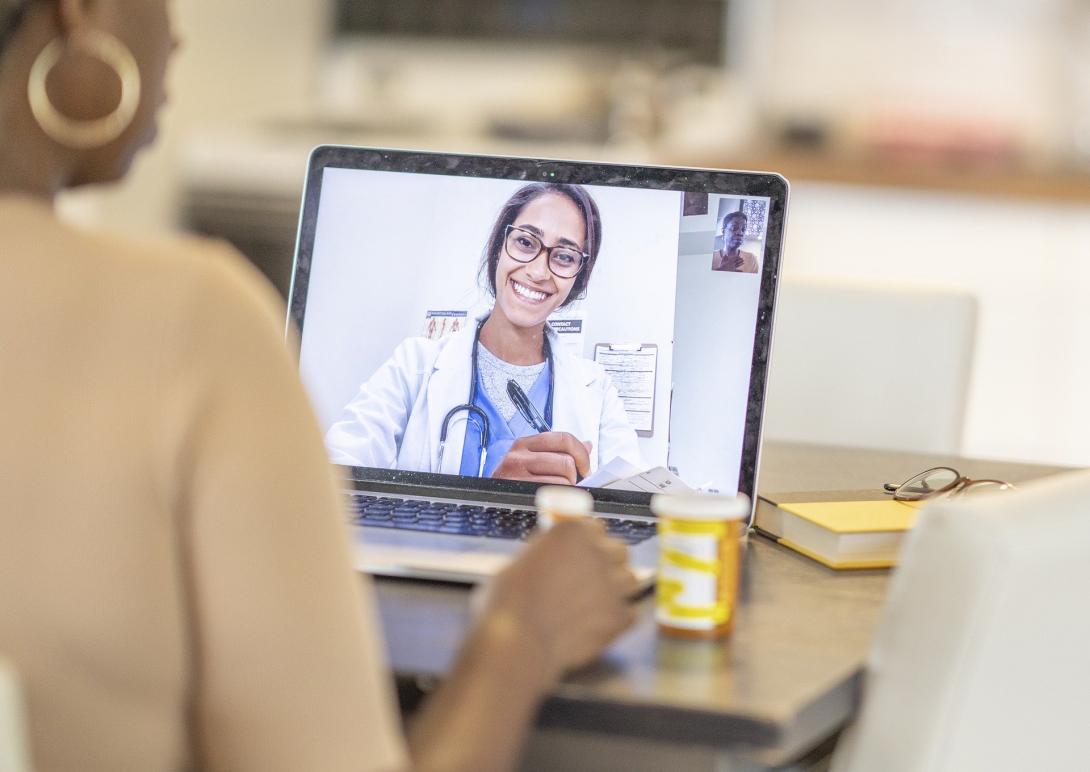The NHS has been forced to change its working patterns over the last 18 months. How has technology enabled this? And what steps are now needed to expand the use of digital post-pandemic? Our latest Panel of Experts share their thoughts
More so than his predecessor Jeremy Hunt, Matt Hancock has used his role as Health Secretary to signal the importance of increasing the pace of digitalisation across the whole NHS estate. Whether it be the promise that outdated and obstructive NHS IT systems will become a thing of the past, evident in the Axe the Fax campaign, or higher use of apps in the NHS as he follows his ‘passion’ of digital innovation, it is clear that the Department of Health and Social Care has a heightened technology agenda under his premiership.
Speaking last July at the Royal College of Physicians, Hancock outlined his firm belief that better tech means better healthcare. Technology has been involved in healthcare for many years, and it is fair to say that improvements in technology have been reflected in the health service. So how has the pandemic shown this?
Simon Townsend, Chief Marketing Officer at IGEL Technology, points to the fact that technology has been at the forefront of developing vaccines, played a vital role in enabling continued and integrated healthcare services, and facilitated a large percentage of the population to safely work from home throughout lockdown. He says that, without the power of the internet and the ability to share data globally, there is no doubt that the vaccines we have today would have taken considerably longer to create and roll out.
Ikenna Emenyonu, Solution Specialist manager at Netcall, says that, just as importantly as the above points, increasing digital use has shown it’s potential to make patient lives easier. A digital approach, Emenyonu writes, also opens the way for two-way comms, online symptom reporting, bite-sized education and shared records. All of which save time and help patients to get the care they need.
The pandemic pressure also encouraged internal process changes, resulting in many teams improving utilisation and reducing waste, proving that tech frees valuable resources.
All agree that it is essential that the NHS continue this momentum. As new variants of the virus continue to arise, technology and the ability for the world to communicate quickly and effectively is fundamental to how we adapt our global vaccine response strategy and delivery. Townsend says that technology, such as 5G, the cloud, unified communications, end-user computing, security and more, continue to play an ever increasingly important role. It enables us to work from anywhere, in the safest possible way, while allowing our healthcare professionals to engage with patients at the point of need.
Emenyonu suggests that some pandemic projects will drop away or be repurposed, but the significant question is how teams can move from ‘getting by’ to ‘getting ahead’ of their next big issue. This is a belief shared by Pinpoint Limited’s Richard Gibson, who cautions that any possible advances should always be carefully weighed up against any potential downsides. While certain sectors of technology have reacted rapidly and positively during the pandemic, and should be lauded for doing so, he argues that this momentum should not be at the expense of maintaining appropriate standards.
According to The NHS Long Term Plan, face-to-face outpatients’ appointments are set to reduce by a third by 2024. Simon Townsend starts our conversation on this topic by stating that there is no doubt that digital practices can help assess people more effectively without them having to visit a local GP practice in the first place. This helps with wait times, overcrowding and obviously, in the midst of pandemic, ensures infection rates are kept at bay.
Richard Gibson is of the belief that it is unlikely that hospitals will ever be ‘free from infection’, as they are primarily centres where people experiencing health problems which include infectious conditions can be treated. The goal, he writes, should be to minimise the level of infection present, and this can be assisted by using such digital practices to diagnose, and in some cases provide treatment, for certain conditions remotely. This reduces the need for people with infectious conditions to congregate at a single point.
However, he goes on to suggest that overcrowding is a very subjective problem – different locations, different health crises, or even different departments of the same hospital can all be a factor in the level of overcrowding. As with infections, digital practices can be used to limit those actually attending a hospital to ‘essential cases’ – with the remainder still being treated effectively, but remotely.
For Simon, technology needs to play a greater role in testing for infections and to provide more effective and faster results. Highlighting the role of smart watches and other smart technology in providing valuable data on an individual’s oxygen levels, heart rate and more, he hopes that such technology will develop in the future so that this kind of technology will become commonplace to identify and manage health issues. This is also favoured by Ikenna Emenyonu, who suggests that an easy-to-use pre-appointment symptom checker helps to keep patients safe by screening and helping symptomatic patients to stay at home.
Hospitals using an arrival app can enable receptionists to manage patient flow from the car park into their clinic, preventing overcrowding. Similarly, traffic through a hospital can be managed using an app. This helps the flow of patients through appointments, coordinating appointments on a day.
Treating patients remotely has proven both convenient and cost-effective, with video and telephony appointments easy for patients to attend with the added benefits of improving available clinical time. Emenyonu says that clinical teams have discovered that virtual workshops add value too. Using group consultations for patients with common clinical concerns makes it easier to share experiences and learn from each other. Importantly, it saves the clinician from repeating information.
Potential risks
Returning to Gibson’s warning that any possible advances should always be carefully weighed up against any potential downsides, we asked our panellists is there are any possible risks and downsides to the speed of technology adoption that we have seen during the pandemic.
The response to coronavirus should be applauded. All organisations in both the public and private sector had to respond quickly to introduce IT so that staff could continue to work but remotely from home.
Changes in the use of technology always introduce some level of possible risk, but, Gibson says, these should be minimised by means of adequate testing. When changes are rushed in ‘at an incredible pace’, the threat can be that shortcuts are taken in the testing/verification process – this can greatly increase the associated risks. Especially in the medical/healthcare field, where lives can literally be in danger, it is essential that the requirement for a rapid solution does not override the need for safe progression.
Simon Townsend says that the impact of the clarion call – to provide computers to staff as fast as possible - is that the areas that IT departments are normally hawklike about such as security, day-to-day management and cost became a lower priority. By providing a high performance endpoint operating system, which can repurpose PC and laptops, Townsend’s company, IGEL, has been laser focused on this, assisting its customers which include many NHS trusts to secure remote workers and reduce IT capital expenditure.
Many have stated that the pandemic has accelerated digital transformation, with some organisations even going so far as to say they have achieved in weeks and months what would have normally taken years. This applies to healthcare, too. But, to repeat the point, the outsourcing of technology and programs, coupled with the need to adapt quickly has raised questions around cost and security moving forward. IT departments need to focus on this now, stresses Townsend.
Another risk of moving at pace is that there isn’t time to explore other possible uses of a specific piece of technology. Typically, it was bought to do one thing. Emenyonu says that it’s essential to explore other uses and extract more from the investment. For example, a Covid Test Result solution may be able to be repurposed for use with other test results.
Deployment under crisis is also rapid, carrying the risk that too much change is brought to the stakeholders. Crisis adoption often falls back to ‘normal behaviour’ after the pressure lifts, as people revert to comfortable ways. But sustainability of the NHS depends on continual improvement. Post crisis, changes that were made should be revisited. But the consultation group should be widened, using their involvement to embed forward movement. By promoting inclusivity, managers will build on their change success.
Will we see a return to old working patterns?
For Gibson, it seems unlikely that there will ever be a complete return to ‘old working patterns’. Townsend agrees, saying that it is highly unlikely we’ll go back to where we were, but stressing that nor will the NHS loose the personal, face-to-face touch shifting to engagements with healthcare professionals which are mostly online.
He says that self-evidently there is a substantial need for many who are extremely sick, cannot access technology or aren’t comfortable using it to see clinicians in person. For Townsend, simply put, the future is hybrid.
Emenyonu tends to view the progress made as a continuation post-pandemic. On one hand, naysayers of digital can’t deny its adoption across all demographics, patients and staff. Secondly, behind the scenes the efficiency gains and cost savings have become part of operations as usual. Unlike before, when technology was always seen as a time-consuming project, the NHS now has the data to confirm what can be done and where extra patient support may be needed.
While there can be some advantages in the technology introduced, as already mentioned under digital practices, there is also a concern that the overzealous aplication of such technology ignores the basic needs of many of the patients. For Emenyonu, the next challenge is in managing high waiting list numbers. He believes that teams can capitalise on the progress they have gained, to flexibly deliver optimal patient pathways at lower costs. However, pandemic or not, he emphasises that digital transformation is here to stay.
Single technology platforms
Even in a future without coronavirus, if that is feasible, hospitals will still have to cope with ever-increasing demands for services. So, how will single technology platforms help address process needs within the health service?
Richard Gibson writes that the ability to share information quickly and effectively undoubtedly assists in the provision of any service, and health is no exception. Single technology platforms should make this process more efficient. As with other technology advances though, he warms that this advance needs to be properly introduced and managed – the data that will be accessible is private and, in some cases, extremely personal.
‘Single platforms’ have, at their core, the ability to integrate, collect and share bidirectional data. Many wrap these terms into one - ‘interoperability’. Done well, Emenyonu says, it allows users to see end-to-end health processes, as if they were from a single platform. Unified data and process flows are impossible with standalone systems.
Our Netcall panellist says that future plans must not accept anything less. Projects must demand open interfaces from all suppliers. The ongoing goal of seamless patient and user journeys will drive this, resulting in a reduction of cost and resource efficiency.
However, digitising paper processes, without open data, is only automating manual work. Hospitals need appropriate visibility of any data from any system, wherever it’s needed. For this, you need ease of integration and suppliers that uphold standards and work well together.
Simon Townsend looks at the question with a focus on the older generation. An ageing population in the UK will continue to place increased demands on the NHS, with the ONS stating in 2019 that in 50 years’ time there’s projected to be an additional 8.2 million people aged 65 years and over in the UK – a number roughly the size of present-day London. However with an increasingly tech-literate population, modern IT, and in particular the consumerisation of it with Zoom, tablets, mobile apps and cloud services, he believes that technology will play an important and ever growing part in enabling self-diagnosis.
Our panellists
Ikenna Emenyonu, Netcall

Ikenna works as a Solution Specialist manager at Netcall. He has deep experience in delivering transformation projects within the NHS. He has been pivotal in understanding the goals, agreeing outcomes and working through challenges within many NHS trusts. His speciality is developing and implementing cost-effective patient experience solutions. Ikenna has been with Netcall for over 15 years.
Richard Gibson, Pinpoint Limited
Richard has a BS. (Hons.) degree in Electronics and Electrical Engineering from Edinburgh University. He spent 10 years in design/development at Ferranti/GEC (Marconi) working on radar and navigation systems for MoD. In the same period, he graduated with a MSc in Digital Systems Engineering from Heriot Watt University. Richard joined Pinpoint in 1997 and has over 24 years of experience in the design and development of the Pinpoint Staff Personal Alarm product portfolio.

Simon Townsend, IGEL Technology
Simon Townsend is IGEL’s chief marketing officer. With more than 20 years experience delivering IT infrastructure and cloud services in both the public and private sector, Simon has spent most of his career in a technical capacity, helping organisations adopt cloud technology and more recently helping firms to embrace the work from anywhere revolution.






